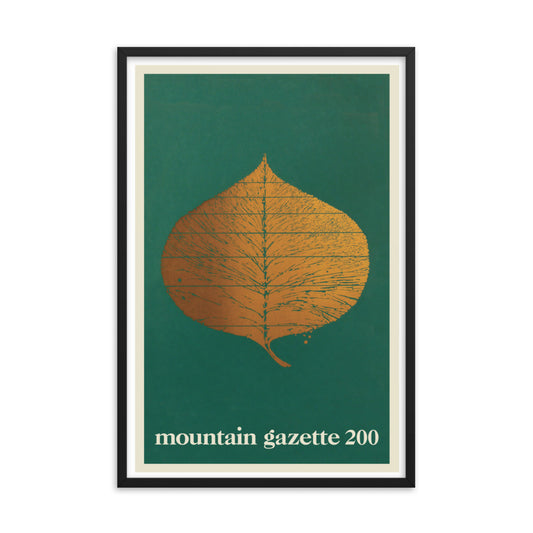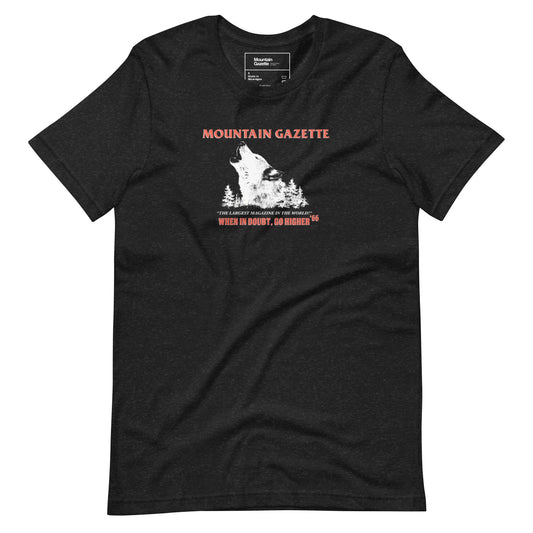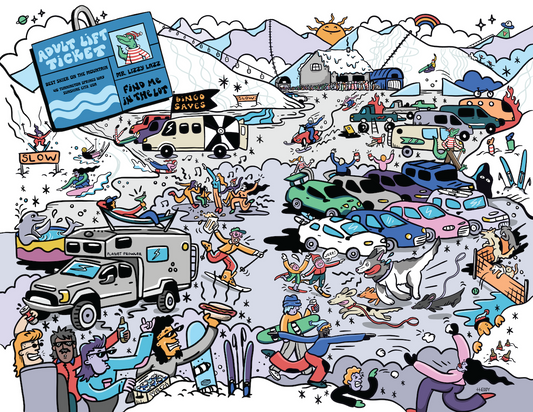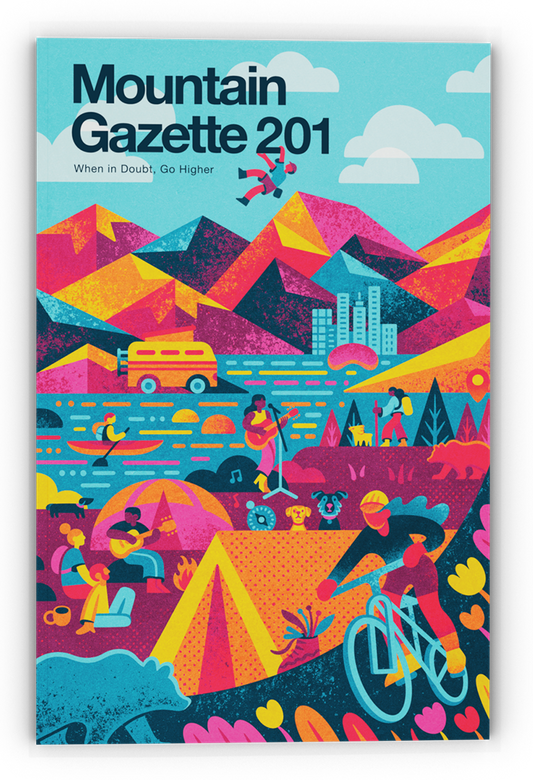The High Country of the Mind
This story originally ran on MountainGazette.com in 2011. We republished it here and featured it in our Sunday email. Subscribe to the newsletter here.
How many mountains does it take to reach the high country of the mind? We often glimpse it, but how do we get there? What does it take to bring the clarity of our experience of the mountains into all aspects of our lives?
By David Scott Gilligan
It is early evening, midsummer in the mountains. The sun disappears behind the high granite peaks. The air cools. The snow that remains here refreezes. Wildflowers which stood boldly open in the bright day— Kalmia, Dodecatheon, Potentilla—shrink back, as the light grows pale and the air cold. The wind that has whooshed and swirled through this place all day long lies down to rest. The land is hushed. I pull on long pants, two wool shirts, a warm hat, lace up my beat-up shoes, and set out up wide granite slabs for the alpine world.
I move with fluidity and efficiency, like an animal. Each breath of the cool, thin air offers a little awakening, and I can feel my body assimilating oxygen molecules. They feel charged. Like the air’s equivalent of whitewater. I set my steps to the rhythm of my breath. My mind clears.
Ahead and above is the wide world of granite, snow, streams and thin bands of green exploding with life, a glacial amphitheater ringed by splintered, serrated gray-and-white peaks which rise like enormous standing waves of stone. A few hundred feet above my camp, I reach a wide bench on which is set a deep lake. It is named Sky Blue Lake, but now it is stark, frozen white, its only open water at its outlet. But there are cracks set across its icy surface and some of these emit an eerie glacial blue color that I can only compare to the Himalayan sky. Above and around the lake the land rises in rounded heaps and benches of snow-covered granite, which form buttressed foundations of the surrounding peaks. Although I can hear the sound of dozens of small cascades of snowmelt, the basin seems silent. Underneath the silence is a deep drone, a humming, a persistent vibration. I have felt this before in the high mountains and on the Arctic tundra, but only a few times. It is hypnotic. It induces a trance-like state in me.
Here, now, during the crack between the light of day and the dark of night, the brash world of our normal experience yields a little bit to the sublime aspect of reality that is always there but difficult to access. The rules of probability, set by reason, give way to a mysterious sense of possibility. It is not hard to imagine enormous mythical wolverines prowling around here or elemental titans acting as conduits for thunderbolts, casting and smashing boulders, raging and laughing and then growing quiet for an age. It is not such a stretch to relate to the sobering madness of legendary Chinese mountain poets, the transfiguration of Judeo-Christian prophets, the terrible and blissful epiphanies of American transcendentalist naturalists. They are all here amidst this utter stillness and freshening cold. Their story is told in the deep, humming song of this place. The Chinese Buddhist monk and poet, Han Shan tells us:
I settled at Cold Mountain long ago,
Already it seems like years and years.
Freely drifting, I prowl the woods and streams
And linger watching things themselves.
Men don’t get this far into the mountains,
White clouds gather and billow.
Thin grass does for a mattress,
The blue sky makes a good quilt.
Happy with a stone underhead
Let heaven and earth go about their changes.
Why do we go to the high mountains? What have such places come to mean in the deep recesses of our consciousness? The answers to these questions lie in our own physical experience: the rhythmic synchronization of breath and step that it takes to ascend into the high country, the alchemy of time on the ground in motion through space, and in our mental process: the meditative trance of the summit experience, the reflections in camp or on the journey home. We respond to time in the high mountains by attaining a state that is relatively rare in the lowlands.
Such a state of being has been described and extolled by many, easterners, westerners and indigenes alike. Han Shan says of life on Cold Mountain “silent knowledge—the spirit is enlightened of itself; contemplate the void: this world exceeds stillness.” Henry David Thoreau exclaims of his glimpse into the high country of the mind while on Katahdin, the lone and barren granitic mountain of northern Maine, “Think of our life in nature,–daily to be shown matter, to come in contact with it,–rocks, trees, wind on our cheeks! The solid earth! The actual world! The common sense! Contact! Contact! Who are we? Where are we?” John Muir urges us to the high country by saying “climb the mountains and get their good tidings. Nature’s peace will flow into you as sunshine flows into trees. The winds will blow their own freshness into you, and the storms their energy, while cares will drop off like autumn leaves.” Here are the answers to the question of why we go to the high mountains.
Hundreds of such descriptions made by mad mountain poets, philosophers, wilderness prophets, as well as explorers, mountaineers, rangers and other backcountry ramblers can be summed up in one short phrase: we go to the mountains for clarity. In the mountains we gain glimpses into the high country of the mind, where our fragmented and unrelated reality resolves into a single, cohesive whole, and the result is a degree of peacefulness and purposefulness seldom attained in everyday life. We feel this by degrees, each according to our own development in this life in space and time, but we all feel it. Thus mountains become temples in the sky, the original monasteries to which we retreat, sallying back to the mundane world of the lowlands, foray after foray, testing the clarity afforded by retreat against the infinite distractions of the marketplace.
Why do we attain such clarity in the high country? The reasons are multiple. Biologically speaking, human beings evolved over a million years of hunting and gathering camp life. The rather sudden cultural transition to an agrarian and eventually industrial lifestyle has been, in short, unsettling to the Pleistocene-attuned human body and mind. Intentionally engaging in aspects of camp life come as a relief to us. As Doug Robinson articulates in The Alchemy of Action, regular physical activity and exertion is the most simple and ancient tonic, the original biochemical high, which makes us simultaneously more ready and more relaxed: more receptive to higher states of consciousness. Combined with the naturally meditative pace of human-powered foot travel, the biochemical and meditative benefits of moving across a landscape are reason enough for periodic refrains to such a lifestyle.
Our minds are further stimulated by the multiplicity of organic, non-repeating forms in the natural world, each an expression of the expanding creativity of phenomenal nature, itself an emanation of the infinite creativity of the Absolute, the Tao, the Source, Ultimate Reality, “Tat”, which can not be named. Muir reminds us, “there are no square-edged inflexible lines in nature.” No two snow crystals are the same, but neither are any two leaves or flowers or fruits, streams, rivers, lakes, skies, stones, to say nothing of the more animated creatures of the world: warm and pulsing birds and mammals, intricately moving insects, sliding, oozing mollusks, all our distant kin. Enmeshed in such a matrix of life, we attend to meaningful activities: listening and smelling for water, finding and collecting fire wood, preparing the food that we need to keep warm, to keep moving. All of this amidst the “quietness”, in the vibrational sense of the word, of a place unsullied by too much human business.
All of this is inherent in wild places, be they desert, mountain, forest or sea. But what of the mountains? What is so singular about the high country? Foremost is the perspective afforded by the combination of the extreme physical exertion implicit in working against the grain of gravity, along with attaining greater and greater heights. More simply put, we can see more the higher we go, and because of the nature of our efforts we are more fit to see. The alchemy of physical exertion is heightened by intentionally engaging in rhythmic breathing exercises while ascending, which alone is a powerful method of increasing one’s receptivity to higher consciousness. The physiological interactions of the body with rarified air exaggerates the effects of such exercise.
At 10,000 feet the body is working with 75 percent the amount of oxygen it gets at sea level; at twenty thousand feet it is working with only 50 percent. As the amount of oxygen in the air decreases, the body’s efforts increase. As the air gets thin, life on Earth becomes more ethereal, and as we are pushed further through the curtain that separates life and death, we see much that was veiled before. Even without such exertion, attaining elevational heights can bring about notable shifts in consciousness, as experienced by many upon seeing the world from the perspective of an airplane. When combined, attaining a heightened alchemical state simultaneous with elevation gain is more powerful than either alone, and tends to dissolve the distinction between literal and metaphorical experiences of reality. As the distinction between these two ways of seeing becomes blurred, our perception on the wholeness of reality becomes clearer.
We ascend into a world that is raw, elemental, primordial and dynamic because it is in a state of genesis. From a geological perspective the high mountains of the world have all uplifted in the Cenozoic Era, mostly in the last twenty million years, and all are tectonically active. In geographic lingo such mountains—those of the Alpine-Himalayan system and the Pacific Rim Cordilleran system—are diagnostically primary mountains, meaning they are happening now. Interestingly, most of these mountains are also primary in the ecological sense: their bedrock either recently erupted and cooled or scoured down to stark naked stone by the episodic comings and goings of Pleistocene ice. Here, then, is the earth still in the making, and here can be felt the atmosphere of infinite possibility inherent in such places. That high mountains tend to be non-arable, sparsely populated (if at all) by humans and biologically spare all contribute to their clean, monastic aesthetic and their wild nature. Their nature is wild, perhaps, along with the deepest oceans, the wildest on earth; they are freshly hewn and direct from the source, unpredictable, free, unsullied by the vibrations of human consciousness. As if to make certain of this, their heightened state often wreathes them in weather, shrouds them in storms, obscures them in clouds, and whitens their flanks. Forests are wiped out in furious avalanches, hundred ton blocks of rock are wedged off of cliff edges by incessant frost, and there is a catharsis of continual contact with the sky.
The raw, elemental, nature of mountains, as well as their dynamic nature of being in a constant state of creation, loom large in the descriptions of those who have known their essences. Han Shan said of Cold Mountain “In the mountains it’s cold. Always been cold, not just this year. Jagged scarps forever snowed in, woods in the dark ravines spitting mist. Grass is still sprouting at the end of June, leaves begin to fall in early August. And here am I, high on mountains, peering and peering, but I can’t even see the sky.” Thoreau said repeatedly of Katahdin that it was raw and unfinished, that it was “primeval, untamed, and forever untamable Nature…the earth of which we have heard, made of Chaos and Old Night…it was the fresh and natural surface of the planet Earth as it was made for ever and ever.” Muir echoed similar sentiments in his own vernacular when reflecting on his experiences in the mountains of California: “…everything is flowing—going somewhere, animals and so-called lifeless rocks as well as water. Thus the snow flows fast or slow in grand beauty-making glaciers and avalanches; the air in majestic floods carrying minerals, plant leaves, seeds, spores, with streams of music and fragrance; water streams carrying rocks both in solution and in the form of mud particles, sand, pebbles and boulders. Rocks flow from volcanoes like water from springs, and animals flock together and flow in currents modified by stepping, leaping, gliding, flying, swimming. While the stars go streaming through space pulsed on forever like blood globules in nature’s warm heart.”
The day wanes and the moon does not rise. The austerity of the landscape is exaggerated by the pale, cold light—there is neither brightness nor shadow. Above the basin, the high peaks grow gray and grim. Above, stars become visible.
The peaks and ridges that surround this basin are alluring. Like all high mountains, they beckon me ever upward, closer to the gods, closer to madness, closer to transfiguration, epiphanies. In the mountains, one’s gaze is most easily drawn upward. Here is a vertical landscape which suggests both literal and metaphorical ascension. The first few high peaks I climbed each brought about a certain transformation. I remember every one of those climbs in detail.
I came to expect such highs, to crave them, to look forward to the next one during the often long spells in the lowlands. The next few years of ascents were still satisfying but less and less remarkable. I can only recall the details of these climbs if I really set my mind to it, and some I have little memory of at all. As I continued to climb, my own attachment to outcome cast a larger and deeper shadow on my relationship with the mountains. Eventually, while teetering in the wind on one high alpine summit after another, I had to ask myself “what am I still doing here? What am I not getting?”
I kept climbing mountains. Eventually, I began to realize that the peaks themselves, though physically the highest places on earth, are only encouragement, and hold no promise of attaining such heights in our own consciousness. I set out to find the high country of the mind. Others led the way:
Men ask the way to Cold Mountain
Cold Mountain: there’s no through trail.
In summer, ice doesn’t melt
The rising sun blurs the swirling fog.
How did I make it?
My heart’s not the same as yours.
If your heart was like mine
You’d get it and be right here.
How many mountains does it take to reach the high country of the mind? We often glimpse it, but how do we get there? What does it take to bring the clarity of our experience of the mountains into all aspects of our lives? When, if ever, do we saunter to the Holy Land, find Cold Mountain, the Pure Land, Ixtlan, Elysium?
The mountains themselves are just places, things, and as such they are ultimately traps. Eventually the rush of novelty passes over them like the ephemeral flush of alpenglow. We develop descriptions of the world and make agreements with others about the way things are. That which was once the most obvious: the numinous, ineffable quality of nature, becomes increasingly lost to us as our attention shifts to a phenomenal nature described in greater and greater detail. If we are not vigilant we bring the chatter and clatter and busyness of the marketplace with us wherever we go, and our forays into the mountains become increasingly disappointing. We keep returning there with secret hopes for an experience unusual enough to break us free of our agreements, our detailed descriptions. We come to expect something of them that ultimately we must find in ourselves. We mistake the physical emanation of the Source for the Source itself, even as we mistake the relativities of our bodies and our minds for our own eternal selves.
No one knows for sure whether Han Shan ever lived on an actual mountain which fit the descriptions of his poems. As Gary Snyder observes, when Han Shan describes Cold Mountain he is describing himself, his state of being. For Han Shan, no mountain climbs were needed to get to the high country of the mind. He was always there and always will be. Thoreau, the transcendentalist-naturalist yogic renunciate of America, did not indulge in much mountain climbing following his ascent of Mount Katahdin. For someone of his disposition, that climb was enough to push him across the threshold into the high country of the mind, and his continual access to the high country is evidenced in the works that followed his experience on Katahdin, most notably in his philosophy of wildness as articulated in his lecture, and later his essay, Walking.
Following Thoreau, John Muir spent ten years sojourning through the high country of the Sierra Nevada of California and the rest of his life in and out of the high country of the mind. I believe that these two, like Han Shan a millennium before them, passed on with the light of such high country in their eyes. There are others. But for most of us, a lifetime of climbing mountains is never enough, the mountains are mistaken for the high country of the mind and we become dependant on them, even while our experience of them diminishes, becomes dissatisfying and disappointing. I never got to meet the legendary Norman Clyde, and though I am in awe of his thousand ascents of North American mountains, I have never envied him. I do not know for certain, but I suspect (perhaps because I have observed this in myself) he passed on unfulfilled, identifying his self with his experiences of the mountains, suffering from attachment to forms, wavering at the threshold.
As I look around at the high peaks and ridges that surround this basin, it strikes me that perhaps all these years I have been headed in the wrong direction, working against gravity instead of with it, climbing up mountains when they themselves are headed down. It strikes me that the ultimate source of every mountain is the sea, and that their story from the moment of their conception is one of gravity and water working together to bring every particle of them to the ocean. The bigger the mountain, the more this is true. I am reminded of the profundity of the hydrological cycle and its implications for the journey of the human soul. We are born like moisture vapor from the sea, gathered into clouds and rained or snowed down upon the world. We spend some time as snowpack, a few eons perhaps in the body of a glacier, then we are released into swift meltwater streams. We become creeks and lakes and rivers, move through plants and animals, eventually, inexorably, drawn back to the source from which we came, until, as the saying goes in the East, “the dewdrop slides into the shining sea.”
This evening, these truths are especially evident in the rapid ablation of the snowpack, the steady exposure of granitic bedrock, the cracking and breaking up of lake ice, the release of the bare ground of gravel flats and alpine meadows, and the cold tumult of a hundred rills and runnels and meltwater streams all rushing downslope. Even now, as the land settles into the stillness of night, the water is ever on the move, flowing down a hundred thousand mountains, over and across the curvature of earth, going back to its source. An ancient passage from the Tao The Ching runs through my mind: “To go far is to return home.” And I am reminded of the even more ancient yogic prayer: “Gone, gone, gone beyond, gone beyond beyond, and beyond that to thy homage.”
I stare awhile at the steady flow of water moving through the slotted outlet of Sky Blue Lake, then set my foot to the stone and begin to follow the water down.
My home was at Cold Mountain from the start,
Rambling among the hills, far from trouble.
Gone, and a million things leave no trace
Loosed, and it flows through the galaxies
A fountain of light, into the very mind—
Not a thing, and yet it appears before me:
Now I know the pearl of the Buddha-nature
Know its use: a boundless perfect sphere.
***
David Gilligan is a wilderness traveler, a naturalist and a writer. He teaches natural history and philosophy courses and leads wilderness expeditions for Sterling College, and has worked previously for Prescott College and the Sierra Institute. His work and personal interests have taken him far afield to mountain regions around the globe. His books include The Secret Sierra, In the Years of the Mountains, Rise of the Ranges of Light and Nature, Culture, Consciousness. davidgilligan.net












